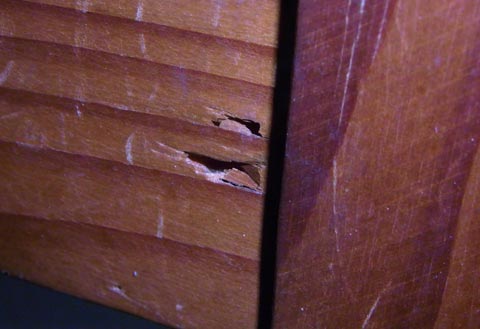Drywood termites can no doubt cause severe damage to wood if they are undisturbed for a long time. It takes several years before the damage becomes really advanced, because drywood termite colonies typically grow slowly, often taking 5 years to reach a mature stage. In the early stages, they usually go unnoticed. So how do you recognize the signs of drywood termites? What do you look out for?Fisrtly, the damage is always localized; basically the damaged area is also nearby where the main nest is situated (although there can be many nests within a building). Therefore, drywood termites are much less of a threat compared to subterranean termites; once their presence has been confirmed, you can then determine what control measures you want to take next.
The signs that drywood termites leave behind are a little different from other termite types, generally speaking. Below are the common signs of drywood termites:
Drywood termite droppings
Drywood termites release their droppings in the form of tiny fecal pellets, which they routinely expel from their nest from tiny kick holes (see below). These tiny 6 sided, egg shaped pellets accumulate over time, in a pile below and around the base of the infested wood. They are commonly referred to as termite frass.
The frass of drywood termites is a lot rougher and harder in texture than the frass of other wood boring creatures like carpenter ants or beetle larvae.

Above – A pile of drywood termite droppings.
Small kick holes
Drywood termites will open up small kick holes from inside their nest, to enable them to eject or “kick” their droppings out from their nest. These kick holes are usually about 1 mm in diameter, as opposed to wood boring beetle larvae holes, which are usually larger.

Above – The kickholes of drywood termites easily go unnoticed.

Above – Drywood termite kickholes are around 1 mm in diameter.
Also, drywood termites do not construct numerous kick holes; these tiny kick holes are a little hard to spot on dark wood surfaces, and for untrained eyes in general. Other wood borers will often drill many more (larger) holes on the wood surface.
Porous wood surfaces
In advanced infestations, drywood termites will construct their galleries very near to the wood surface, resulting in weak and porous areas that can easily be punctured through. Sometimes these hollow spots appear by themselves when the wood is really damaged.

Above – There will be spots where the wood will be easily punctured, but these only become apparent when the damage is quite advanced.
Drywood termite swarmers
The swarming alates of drywood termites are released frequently, but in relatively small swarms each time, as opposed to other types of termites (like some subterranean termite species which swarm by the thousands). But they do leave tell tale signs like their wings, scattered on the floor after they fly.

Above – A drywood termite swarmer or alate.
The swarmers of drywood termites look very much like other flying termites. The wings of drywood termite swarmers look a little different from other termites, as in being finer, and with a more elaborate vein structure when scrutinized with a magnifying glass.

Above – The wings of drywood termite swarmers are small and give the appearance of being thinner and more fragile than the wings from other flying termite types. Also, the veins on the wings are more complex looking.
Flying drywood termites can swarm from their nest during daylight hours, depending on the species. Since only a few are released from each nest each time, they often go unnoticed, and their wings are often the only clue that there was a swarming event.
